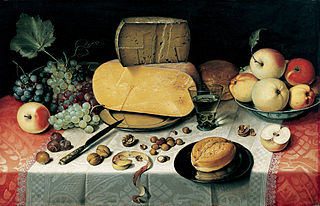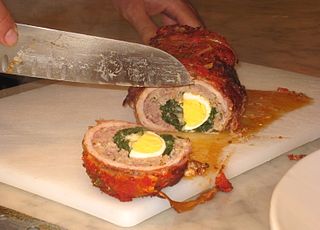 W
WMedieval cuisine includes foods, eating habits, and cooking methods of various European cultures during the Middle Ages, which lasted from the fifth to the fifteenth century. During this period, diets and cooking changed less than they did in the early modern period that followed, when those changes helped lay the foundations for modern European cuisine. Cereals remained the most important staple during the early Middle Ages as rice was introduced late, and the potato was only introduced in 1536, with a much later date for widespread consumption. Barley, oats and rye were eaten by the poor. Wheat was for the governing classes. These were consumed as bread, porridge, gruel and pasta by all of society's members. Fava beans and vegetables were important supplements to the cereal-based diet of the lower orders.
 W
WAlmond milk is a plant milk with a creamy texture and nutty flavor manufactured from almonds, although some types or brands are flavored in imitation of cow's milk. It does not contain cholesterol or lactose and is low in saturated fat. Almond milk is often consumed by those who are lactose-intolerant and others, such as vegans, who avoid dairy products. Commercial almond milk comes in sweetened, unsweetened, vanilla and chocolate flavors, and is usually fortified with micronutrients. It can also be made at home using a blender, almonds and water.
 W
WBeer soup is a soup which is usually roux-based and made with beer. In medieval Europe, it was served as a breakfast soup, sometimes poured over bread.
 W
WCatalan cuisine is the cuisine from Catalonia. It may also refer to the shared cuisine of Roussillon and Andorra, the second of which has a similar cuisine to that of the neighbouring Alt Urgell and Cerdanya comarques and which is often referred to as "Catalan mountain cuisine". It is considered a part of western Mediterranean cuisine.
 W
WDillegrout or dilligrout is a dish traditionally presented at the coronations of kings and queens of England by the holders of the manor of Addington in a kitchen serjeanty. It is generally thought to be a soup or stew made from almond milk, capon, sugar, and spices, but a porridge-like dish of other ingredients has been described. Dillegrout was first presented in 1068 at the coronation of Matilda of Flanders, wife of William the Conqueror, and its final presentation was at the coronation of George IV in 1821.
 W
WAn entremet or entremets in French cuisine historically referred to small dishes served between courses but in modern times more commonly refers to a type of dessert. By the end of the Middle Ages, it had evolved almost entirely into dinner entertainment in the form of inedible ornaments or acted performances, often packed with symbolism of power and regality. In English it was more commonly known as a subtlety and did not include acted entertainment, but most famously did have live blackbirds flying out of a pie, a scene immortalized in the folk song Sing a Song of Sixpence.
 W
WFarsu magru, also spelled as farsumagru, and also referred to as farsumauru, falsomagro and falsumagru, is a traditional meat roll dish in Sicilian cuisine that dates to the 13th century. Farsu magru is available in many areas of Sicily, but some only serve it for special occasions. This roast is prepared mainly in rural regions in the interior of the island. Farsu magru means " false lean", which has been attributed to the amounts of meat used in the dish, and also to the lean, low-fat nature of the meats typically used.
 W
WFrumenty was a popular dish in Western European medieval cuisine. It is a porridge, a thick boiled grain dish—hence its name, which derives from the Latin word frumentum, "grain". It was usually made with cracked wheat boiled with either milk or broth and was a peasant staple. More luxurious recipes include eggs, almonds, currants, sugar, saffron and orange flower water. Frumenty was served with meat as a pottage, traditionally with venison or even porpoise. It was also frequently used as a subtlety, a dish between courses at a banquet.
 W
WGingerbread refers to a broad category of baked goods, typically flavored with ginger, cloves, nutmeg and cinnamon and sweetened with honey, sugar or molasses. Gingerbread foods vary, ranging from a soft, moist loaf cake to something close to a ginger snap.
 W
WGreen sauce or greensauce is a family of cold, uncooked sauces based on chopped herbs, including the Spanish and Italian salsa verde, the French sauce verte, the German Grüne Soße or Frankfurter Grie Soß, the British mint sauce and greensauce, and the Argentinian chimichurri.
 W
WThe hochepot is a sort of stew much appreciated in the Nord-Pas-de-Calais region of France, and in Flanders and Hainaut in Belgium. Its origins go back to the Middle Ages and its first known recipes are in the Manuscript of Sion, the oldest treatise of cooking written in French around the 13th century. Although almost the same word is used in both Dutch and French, it has nothing to do with Dutch hutspot which is a dish made from mashed potato and whose recipe is said to have been concocted during the siege of Leiden in 1574.
 W
WManchet, manchette or michette (French), is a wheaten yeast bread of very good quality, or a small flat circular loaf. It was a bread that was small enough to be held in the hand or glove.
 W
WA perpetual stew, also known as hunter's pot or hunter's stew, is a pot into which whatever one can find is placed and cooked. The pot is never or rarely emptied all the way, and ingredients and liquid are replenished as necessary. The concept is often a common element in descriptions of medieval inns. Foods prepared in a perpetual stew have been described as being flavorful due to the manner in which the ingredients blend together, in which the flavor may improve with age.
 W
WPiper cubeba, cubeb or tailed pepper is a plant in genus Piper, cultivated for its fruit and essential oil. It is mostly grown in Java and Sumatra, hence sometimes called Java pepper. The fruits are gathered before they are ripe, and carefully dried. Commercial cubeb consists of the dried berries, similar in appearance to black pepper, but with stalks attached – the "tails" in "tailed pepper". The dried pericarp is wrinkled, and its color ranges from grayish brown to black. The seed is hard, white and oily. The odor of cubeb is described as agreeable and aromatic and the taste as pungent, acrid, slightly bitter and persistent. It has been described as tasting like allspice, or like a cross between allspice and black pepper.
 W
WPottage or potage is a term for a thick soup or stew made by boiling vegetables, grains, and, if available, meat or fish. It was a staple food for many centuries. The word pottage comes from the same Old French root as potage, which is a dish of more recent origin.
 W
WPottage or potage is a term for a thick soup or stew made by boiling vegetables, grains, and, if available, meat or fish. It was a staple food for many centuries. The word pottage comes from the same Old French root as potage, which is a dish of more recent origin.
 W
WA sop is a piece of bread or toast that is drenched in liquid and then eaten. In medieval cuisine, sops were very common; they were served with broth, soup, or wine and then picked apart into smaller pieces to soak in the liquid. At elaborate feasts, bread was often pre-cut into finger-sized pieces rather than broken off by the diners themselves. The bread or croutons traditionally served with French onion soup, which took its current form in the 18th century, can be considered modern-day sops.
 W
WA trencher is a type of tableware, commonly used in medieval cuisine. A trencher was originally a flat round of bread used as a plate, upon which the food could be placed to eat. At the end of the meal, the trencher could be eaten with sauce, but could also be given as alms to the poor. Later the trencher evolved into a small plate of metal or wood, typically circular and completely flat, without the lip or raised edge of a plate. Trenchers of this type are still used, typically for serving food that does not involve liquid; for example, the cheeseboard.
 W
WVerjuice is a highly acidic juice made by pressing unripe grapes, crab-apples or other sour fruit. Sometimes lemon or sorrel juice, herbs or spices are added to change the flavour. In the Middle Ages, it was widely used all over Western Europe as an ingredient in sauces, as a condiment, or to deglaze preparations. It is still used to some extent in the American South.